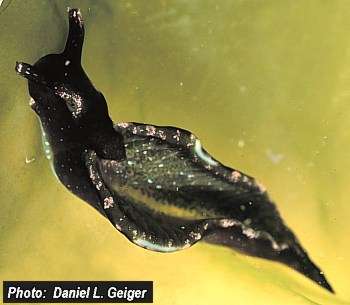
Elysia viridis
(Montagu, 1804)
Order: SACOGLOSSA
Superfamily: ELYSIOIDEA
Family: Elysiidae
DISTRIBUTION
Northeast Atlantic from Norway to the Mediterranean.
PHOTO
on intertidal Ulva. Millport, Isle of Cumbrae, Scotland, United Kingdom, May 1992
PHOTO: Daniel G. Geiger.
RELATED TOPIC
It grows to about 45mm in length and its body colour, green to bright red, is dependent on the colour of the algae it is feeding on. There are usually scattered iridescent red, blue and green spots, and there can be white patches on the parapodial edges and black markings in the head and elsewhere. Branching ducts and lobes of the digestive gland are visible through the body wall in all parts of the body.
Elysia viridis has been reported from a variety of species of alga, but it actually eats the filamentous algae Cladophora and Chaetomorpha as well as coenocytic algae Codium and Bryopsis (see Trowbridge message). It is able to retain living plastids from its algal food, allowing the plastids to continue to photosynthesise within its body. The slug's colour is algal-derived, leading to the different color "morphs" which have been reported for this species.
Reference:
• Thompson, T.E. (1976) Biology of Opisthobranch Molluscs, Vol 1. Ray Society: London.
Rudman, W.B., 1999 (August 14) Elysia viridis (Montagu, 1804). [In] Sea Slug Forum. Australian Museum, Sydney. Available from http://www.seaslugforum.net/find/elysviri
Related messages
Elysia from the Azores
April 5, 2010
From: Sérgio Ávila
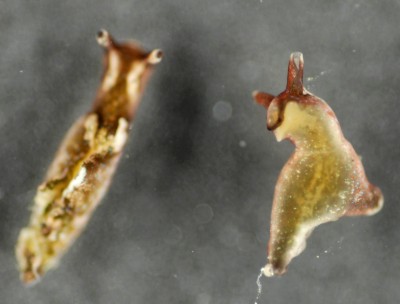
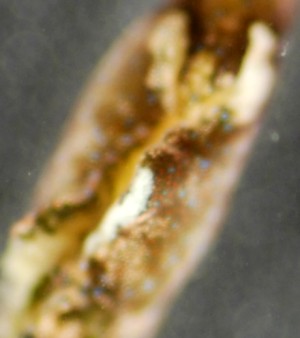
Dear Bill:
A PhD student (Ricardo Cordeiro) collected in the intertidal a lot of juveniles of what appear to me to be Aplysia specimens. However, I am not an expert in Opisthobranchs and, apparently, they do not fit on the descriptions of the species reported to the Azores:
- Aplysia parvula Guilding in Mörch, 1863
- Aplysia depilans Gmelin 1791
- Aplysia fasciata Poiret, 1798
- Aplysia punctata Cuvier, 1803
Locality: Caloura beach, São Miguel Island, Azores archipelago, Azores, Northeast Atlantic, 31 March 2010, Intertidal, in algae. Length: 3mm. Photographer: Sérgio Ávila.
Thanks!
Sérgio Ávila
Research Associate
Department of Biology
University of the Azores
Portugal
www.uac.pt/~fosseis
avila@notes.uac.pt
Ávila, S.P., 2010 (Apr 5) Elysia from the Azores. [Message in] Sea Slug Forum. Australian Museum, Sydney. Available from http://www.seaslugforum.net/find/23436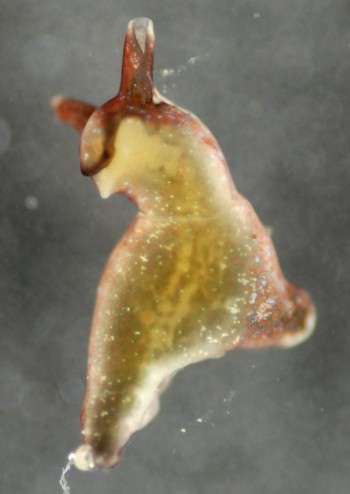
Dear Sérgio,
I think this is Elysia viridis which has been reported from the Azores. There is a somewhat similar species also reported from the Azores, E. gordanae but it lacks the large blue spots.
I woud appreciate some advice from local experts as Malaquias et al say Elysia gordanae can be differentiated from E. viridis "by the presence of a pinkish-white coloration that covers the edge of the parapodia, rhinophores, head and mid-dorsal region of body" but I thought E. viridis often had pinkish colouration as well?
It would be good to know if the large blue spots, when present, are indicative of E. viridis, or are they also found in E. gordanae?
- Malaquias, M.A., Calado, G.P., Padula, V., Villani, G., Cervera, J.L. 2009. Molluscan diversity in the North Atlantic Ocean: new records of opisthobranch gastropods from the Archipelago of the Azores. Marine Biodiversity Records, . Marine Biological Association of the United Kingdom. 2; e38 :1-9. Published online
Best wishes,
Bill Rudman
Elysia viridis from Crete Island, Greece
November 9, 2009
From: Marina Poddubetskaia Ossokine
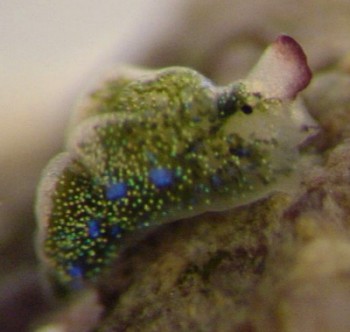
Dear Bill,
Few weeks ago I snorkelled in Crete Island and I saw there some common Mediterranean sea slug species, but also this nice unidentified Elysia with only one rhinophore. If someone recognize this species, I would be happy to have a name for it.
Locality: "Alexander Beach", Malia, Crete Island, 2m, Greece, Mediterranean Sea, 19 April 2009. Length: 3mm. Photographer: Marina Poddubetskaia.
Best wishes,
Marina.
Photos: Marina Poddubetskaia - Nembro website
nembro@yahoo.fr
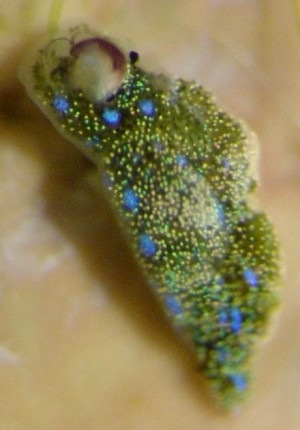
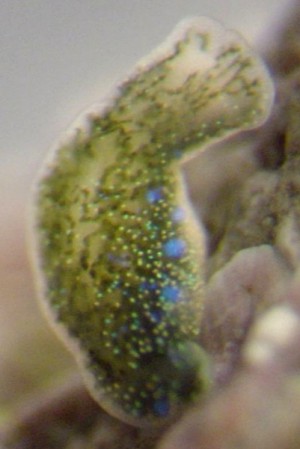
Dear Marina,
Sorry this has taken a while to post. It is a juvenile Elysia viridis [see message #5944]. The blue spots seem to be proportionally much larger in juveniles
Best wishes,
Bill Rudman
Re: Elysia viridis from Mediterranean sea
May 12, 2009
From: Dominique Horst
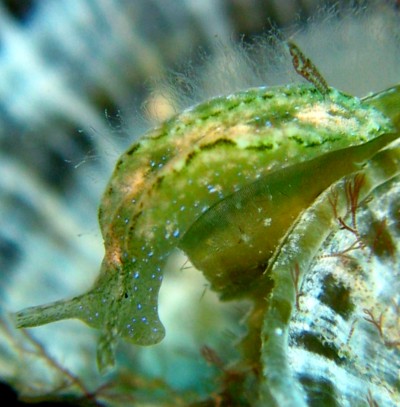
Concerning message #21032:
Hi Bill,
Looking at all the messages about Elysia viridis, I've deduced I have met Elysia viridis at last.
It seems that this species has many colour variations. Is there any explanation about a possible function of the blue spots ?
Locality: Antibes, 12 m, France, Mediterranean sea, 3 May 2009. Length: 10mm. Photographer: Dominique Horst.
Kind regards,
Dominique
dominique.horst@wanadoo.fr
Horst, D., 2009 (May 12) Re: Elysia viridis from Mediterranean sea. [Message in] Sea Slug Forum. Australian Museum, Sydney. Available from http://www.seaslugforum.net/find/22439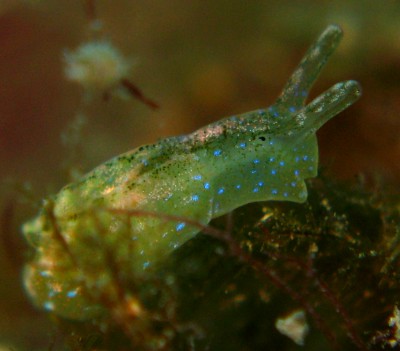
Dear Dom,
I'm afraid I know of no explanation for these iridescent blue spots. They are found in some other species of Elysia but whether this should suggest a functional significance or whether it is just a co-incidence I can't say.
Best wishes,
Bill Rudman
Elysia viridis from Scotland
April 8, 2008
From: Jim Anderson
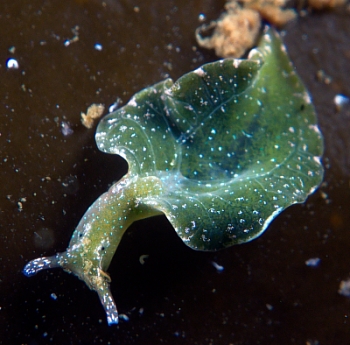
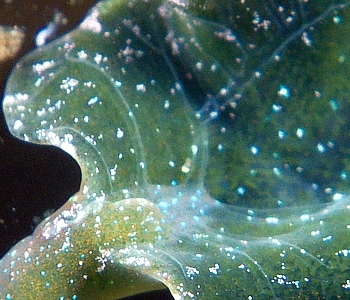
Dear Bill,
I've never had much luck finding this common species until late last year (28 Oct) when we found hundreds in the shallows of the sea loch we were diving. They were abundant on kelp and rocky substrates with many 'flattened' out into the leaf shape they adopt. It was not a particularly sunny day but bright.
Locality: Jenny's Reef, Loch Long, 6 m, Scotland, Atlantic Ocean, 28 October 2007, Sea loch. Length: 25 mm. Photographer: Jim Anderson.
Jim Anderson
jander4454@gmail.com
Anderson, J, 2008 (Apr 8) Elysia viridis from Scotland. [Message in] Sea Slug Forum. Australian Museum, Sydney. Available from http://www.seaslugforum.net/find/21032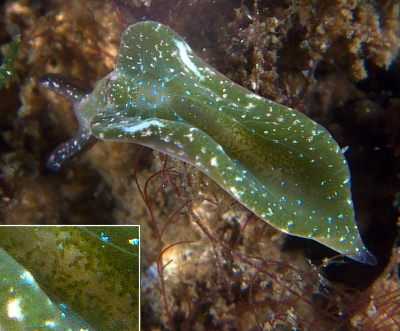
Dear Jim,
It's good to get photos of some of these 'common' animals. It's surprising how often they are the worst represented in collections both in terms of specimens and photos. I have added a couple of close-ups to show some features of this species. In the upper photo we can see the vessels which branch out over the parapodia. Some researchers consider the branching pattern differs characteristically in each species.
In the lower photo I have included an inset showing the accumulation of living green algal chloroplasts which are nutured in some species [see Solar-powered sea slugsPage]
Best wishes,
Bill Rudman
Elysia from Tunisia
May 24, 2007
From: Dorra Maaoui
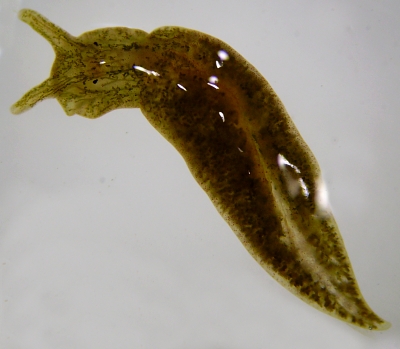
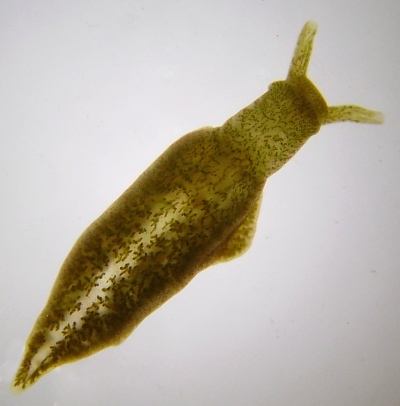
Dear Sir,
I photographied a sea slug that seems to be Elysia viridis but I am not sure about the species.
I would appreciate your comments.
Sincerely yours,
Dorra Maaoui
Student in Marine environment, Tunisia
maaoui.dorra@wanadoo.tn
Maaoui, D., 2007 (May 24) Elysia from Tunisia. [Message in] Sea Slug Forum. Australian Museum, Sydney. Available from http://www.seaslugforum.net/find/19931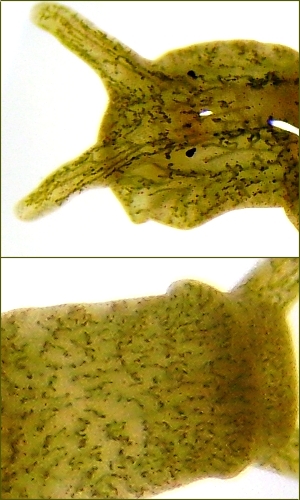
Dear Dorra,
I am pretty sure this is Elysia viridis, but it does lack any sign of the blue spots often found on this species. Hopefully a local expert can confirm your identification. I have added a couple of close-ups showing dorsal and ventral views of the head to show the ramifying branches of the digestive gland which contain the green chloroplasts from its algal food.
Best wishes,
Bill Rudman
Unknown Elysia from Croatia
March 27, 2007
From: Mat Vestjens
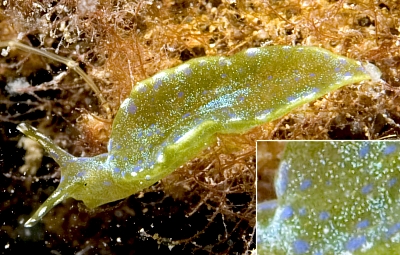
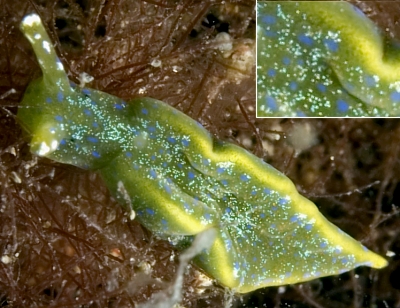
Hallo Bill,
Attached I send you three pictures of Elysia. Number 1 and 2 were taken at a depth of 30 metres, number 3 was very shallow approximately 3 metres. Due to the blue pigmentation, I was thinking it could be E. viridis, but these animals stay very small (max. 5 mm) and E. viridis gets much larger than that as I know from Holland. Are these all the same species and can it be E. viridis? If so, why don't they get larger than 5 mm? There is plenty of food.
Locality: Selce, 5 - 30 metres, Croatia, Adriatic, 16 September 2006. Length: < 5 mm. Photographer: Mat Vestjens.
Best regards,
Mat Vestjens
annenmat@natuurlijkmooi.net
Vestjens, M.G., 2007 (Mar 27) Unknown Elysia from Croatia. [Message in] Sea Slug Forum. Australian Museum, Sydney. Available from http://www.seaslugforum.net/find/19766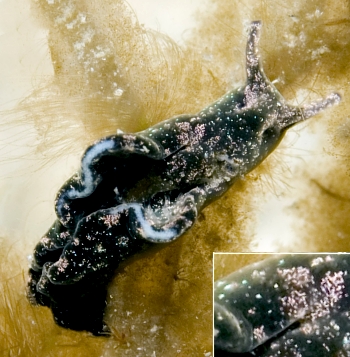
Dear Mat,
I would welcome some comments from local experts. The dark green one looks like E. viridis, but looking at the filamentous algae in the background of that photo, it looks a bit bigger than 5 mm?
The animals in upper two photos have much larger blue spots than for any E. viridis I can recall, except for one juvenile from Sweden [message #5944] but in that case, the animal's proportions are clearly that of a juvenile. Yours animals all seem to have adult proportions. I haven't done an exhaustive search of the literature but I can't think of a Mediterranean Elysia with such large blue spots.
Best wishes,
Bill Rudman
Elysia viridis from South Devon, UK
July 3, 2006
From: Judith Oakley
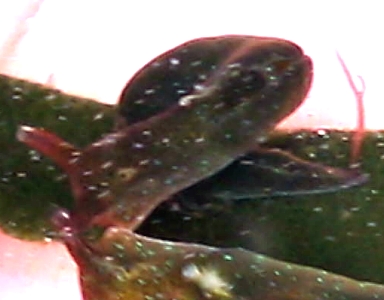
Dear Bill
Haven't had much chance since last year to search for sea slugs in marinas. There has been a lack of slugs in rockpools and on the shore this year. Have only found 1 x Aplysia punctata and 1 x Aeolidia papillosa. However, I did find 6 x Elysia viridis with eggs Codium tomentosum. They were fascinating and the first time I have seen the species - lovely green colour with bright blue spots. Am attaching some photos but not very good as tide was coming in quickly and I couldn't keep camera or algae still!
best wishes
Locality: Gorah Rocks, East Prawle, Devon, UK, 29 June 2006, in rockpool on Codium tomentosum. Length: 1 inch. Photographer: Judith Oakley.
Judith Oakley
jomoakley@btinternet.com
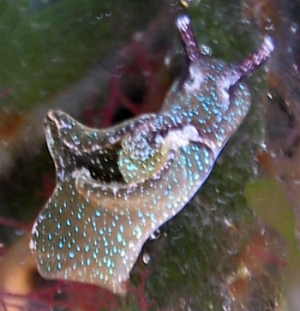
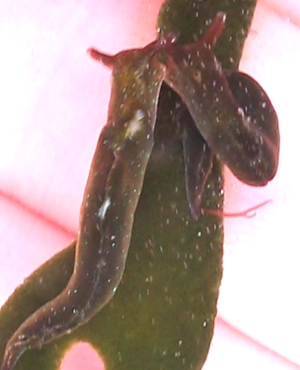
Thanks Judith,
It's nice to have photos of some of the relatively common species. It is surprising how often they are overlooked.
Best wishes,
Bill Rudman
Elysia viridis from the Baltic Sea
September 2, 2005
From: Dirk Schories
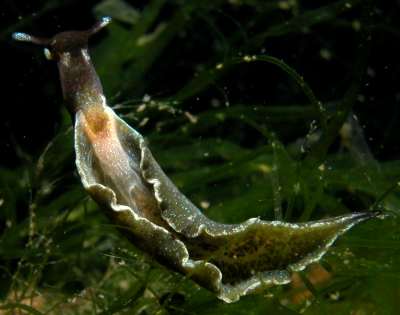
Hi to all,
A few years ago Peter Gleisenstein reported Aplysia punctata from the Flensburger Förde (Germany). Actually we suppose that we have found this species also a little bit more east close to the Olympic harbour of Schilksee (Kieler Bight, Baltic Sea). Salinity is about 15 PSU. Several species were found in depth between 2-4m on Gracilaria sp. (most probably recently introduced to the Baltic) and other filamentous algae.
Locality: Schilksee harbour, Germany, Baltic Sea. Depth: 2-4 m. Length: 10 mm. 22 August 2005. Photographer: Dirk Schories
Greetings,
Dirk
dirk.schories@gmx.de
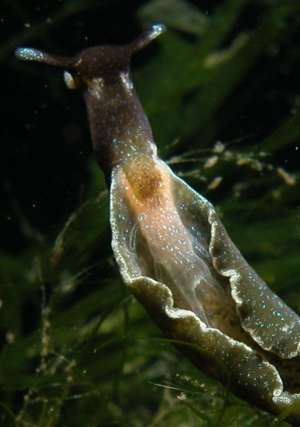
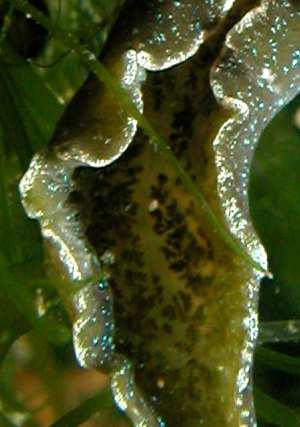
Dear Dirk,
This is the sacoglossan Elysia viridis rather than a sea hare such as Aplysia. Sea Hares have two pairs of head tentacles rather than the single pair in your animal and the side flaps [parapodia] in Sea Hares enclose the remnants of a mantle cavity with an internal shell and a gill. In elysioid sacoglossans the parapodia are in fact 'the body' in at least the posterior two-thirds of the body. At the anterior end, the parapodia enclose a swelling which contains the heart from whch a network of blood vessels branch out over the inside of the parapodia [see lower left photo]. In the lower right photo you can see dark green masses inside the parapodial wall. These are clumps of plant chloroplasts being kept alive in specialised ducts of the digestive system. Elysia viridis is a very interesting animal belonging to a group which I call 'solar-powered'. The sacoglossans that exhibit this symbiosis obtain the chloroplasts from the green algae they feed on. Have a look at the relevant Fact Sheets for more information.
Best wishes,
Bill Rudman
Elysia viridis post-larvae?
March 25, 2004
From: Bart Teugels
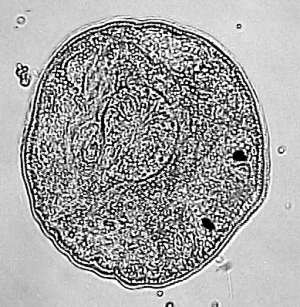
Hi Bill,
I am Bart Teugels, thesis student of the VUB University (Brussels). I am doing my thesis on Elysia viridis, especially carbon and (possible) inorganic nitrogen assimilation. I've made some pictures with the microscope of larvae. I found them in my aquaria, but I am not sure if they are postlarvae from Elysia viridis. In the attachment you find the photographs. Maybe you can help me with identifying them.
For the introduction of my thesis I am looking for a classification of the order of the Sacoglossa. I've already found a lot of sources, but all of them give a different classification. Do you know where I can find the most recent or best classification of the moment?
Best regards
Bart
bateugel@vub.ac.be
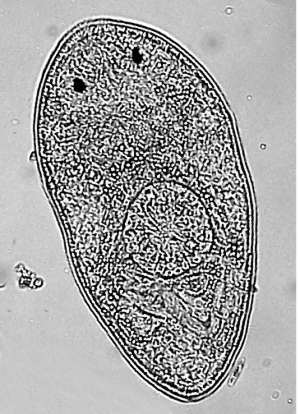
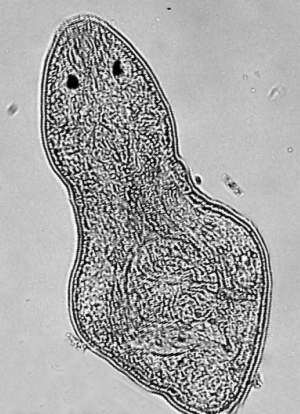
Dear Bart,
You don't give an indication of size, and I am pretty sure these are photographed with a glass cover-slip on top. My gut feeling is that these are some sort of flatworm. Although in the lower right photo there appears to be some structure between the eyes I don't think it is well developed enough for the pharnyx/ buccal bulb of a sacoglossan. I think the big structure midway down the body is the ventral pharynx of a flatworm. I could be quite wrong so if anyone has a good idea can they let us know.
Concerning a good classification of the sacoglossans. At the moment, like most mollusc groups, our higher classification of the sacoglossans is in a state of change. Kathe Jensen's (1996) review is the latest major study but I am sure Kathe can let us know if there are chnages or later work we should be aware of
• Jensen, K.R. (1996) Phylogenetic systematics and classification of the Sacoglossa (Mollusca, Gastropoda, Opisthobranchia). Philosophical Transactions of the Royal Society of London, B 351: 91-122.
Best wishes
Bill Rudman
Elysia from Tunisia
July 29, 2003
From: J. Ben Souissi and A. Eters
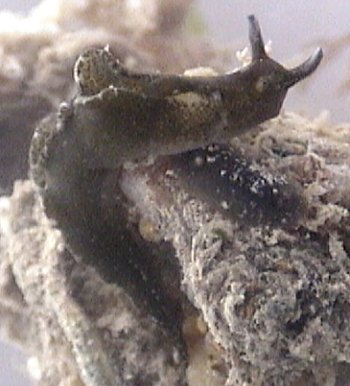
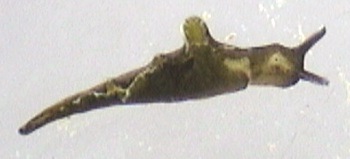
Dear Bill,
Here is an Elysia from our coastal lagoon, "Lac de Tunis" [south section] in Tunis, Tunisia, North Africa. Depth: 0 to 1m some time between January and March, 2003.
Can you identify it please.
Thanks,
Jamila Ben Souissi and Anis Eters
bensouissi.jamila@inat.agrinet.tn
Ben Souissi, J. & Eters, A., 2003 (Jul 29) Elysia from Tunisia. [Message in] Sea Slug Forum. Australian Museum, Sydney. Available from http://www.seaslugforum.net/find/9886Dear Jamila & Anis,
This is the same species as the one in the top photo of your message about Philinopsis depicta. Kathe Jensen noted, that this is most probably Elysia viridis.
Best wishes,
Bill Rudman
Elysia viridis from Guernsey
July 15, 2003
From: Richard Lord
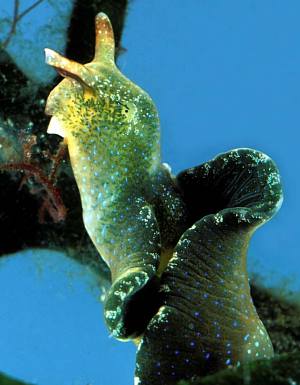
Dear Bill:
Here is a photo of Elysia viridis collected recently from a rock pool on L'Eree beach on Guernsey's west coast. [Guernsey, Channel Ids, Great Britain, 20 April 2003]
Best Wishes,
Yours sincerely,
Richard
fishinfo@guernsey.net
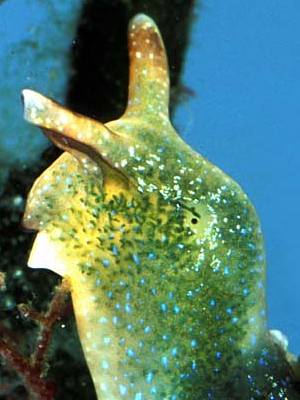
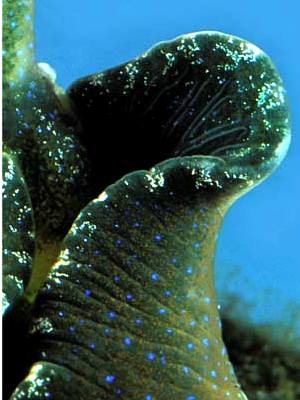
Thanks Richard,
I have included a couple of close-ups to show some of the anatomical detail. The lower left photo shows the network of digestive gland ducts coloured green by the chloroplasts it obtains from feeding on the green algae Codium on which i is photographed. The lower right photo shows the blood vessels [dorsal veins] on the inside surface of the parapodia.
Best wishes,
Bill Rudman
Elysia viridis from the Sussex coast, England
May 21, 2003
From: Andy Horton
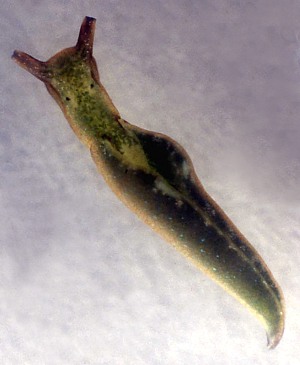
Hello,
In an earlier message about Elysia viridis from the Sussex coast, England (English Channel coast) I stated that the animal did not have spots. Now I have with an improved scanner, I discover that this specimen does have the blue spots. 15mm long
Cheers,
Andy Horton.
British Marine Life Study Society
glaucus@hotmail.com
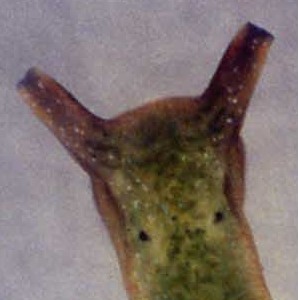
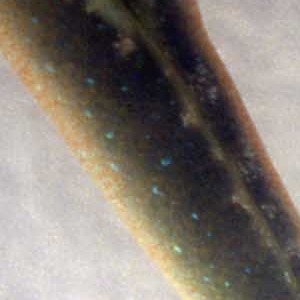
Thanks Andy,
The blue spots are quite noticeable in close-up.
Best wishes,
Bill Rudman
Re: Philinopsis depicta from Tunisia
May 6, 2003
From: Kathe R. Jensen
Dear Bill and Anis,
Have you noticed the small Elysia - probably E. viridis - at the bottom of the top photo of Philinopsis depicta? This lagoon seems to be a sea slug heaven.
Greetings,
Kathe
krjensen@zmuc.ku.dk
Dear Kathe,
The little Elysia is today's offering - and your identification saves me checking with you. The thing that interests me about Anis's collection is how similar the fauna is to what I would expect to find in a similar coastal lagoon in eastern Australia. Obviously the species would be different, but the same families - and even genera would be represented.
Best wishes
Bill Rudman
Elysia viridis from Tunisia
May 6, 2003
From: Anis
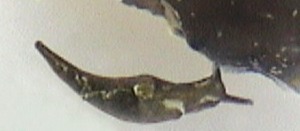
Dear Bill,
I found this sea slug in a coastal lagoon, "Lac de Tunis" [south section] in Tunis, Tunisia, North Africa. Depth: 0 to 1m some time between January and March, 2003.
Can you identify it please.
Thanks,
Anis
bensouissi.jamila@inat.agrinet.tn
Anis, 2003 (May 6) Elysia viridis from Tunisia. [Message in] Sea Slug Forum. Australian Museum, Sydney. Available from http://www.seaslugforum.net/find/9708Dear Anis,
As Kathe Jensen has noted, this is a species of Elysia, most probably Elysia viridis.
Best wishes
Bill Rudman
Re: Elysia viridis?
May 1, 2002
From: Peter H. van Bragt
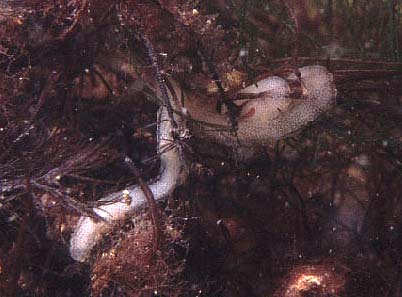
Hello Bill and Erwin,
I would like to post an argument in favour of Erwin's Elysia sp. NOT being E. viridis. The egg mass that Erwin has photographed is very different of the egg masses that we always find in the close proximities of E. viridis in the Dutch coastal waters. Here it is never such a nicely spiraled coil but a very loose ribbon hanging in or on various species of seaweed.I have included a picture of such an egg mass that was photographed in August 2001 in the Oosterschelde Bay, the Netherlands.
Best regards
Peter H. van Bragt
vanbragt.phjm@hsbrabant.nl
van Bragt,P.H., 2002 (May 1) Re: Elysia viridis?. [Message in] Sea Slug Forum. Australian Museum, Sydney. Available from http://www.seaslugforum.net/find/5335Thanks Peter,
The other difference is the size of the eggs. In Erwin's photo they are very large, suggesting direct development, while in your photo the eggs are small, matching the planktotrophic larval stage know to occur in E. viridis. Unfortunately this still leaves Erwin's photo unidentified.
Best wishes,
Bill Rudman.
Two pics of juvenile Elysia viridis
January 11, 2002
From: Mike Noren
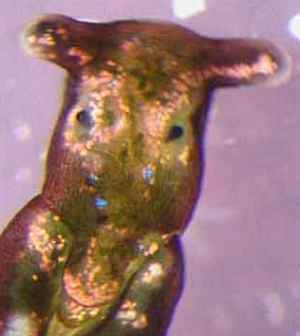
Dear Bill,
Here are two pics of juvenile Elysia viridis. The slugs were collected at Tjärnö on the Swedish west coast; depth and substrate unrecorded. Size is about 3-4mm. The pictures do not do justice to their brilliant coloration.
Juveniles like those on the pics are common at Tjärnö, but in all the years I've frequented the station I do not believe I've ever seen any E. viridis bigger than about 10mm there.
Mike Noren
mike_noren@hotmail.com
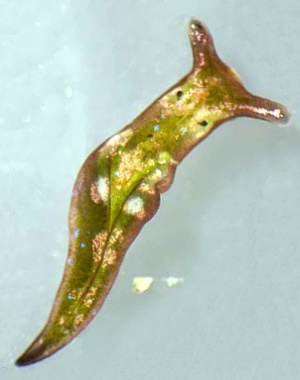
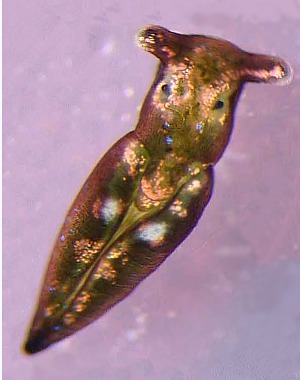
Thanks Mike,
Although I am not familiar with Elysia viridis, I can agree that the brilliant and iridescent colours you can see in many sacoglossans under the microscope are seldom captured in photographs. I have included a close-up of the head of one of your animals to show the beginnings of the branching of the gut throughout the body wall to house the chloroplasts that it 'steals' from its plant food, to keep alive and photosynthesising.
Cheers,
Bill Rudman
Elysia viridis from the Netherlands
October 6, 2000
From: Peter H. van Bragt
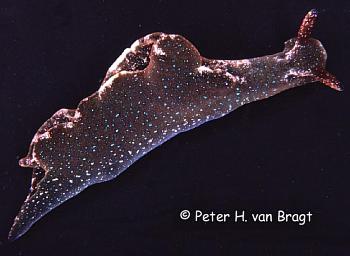
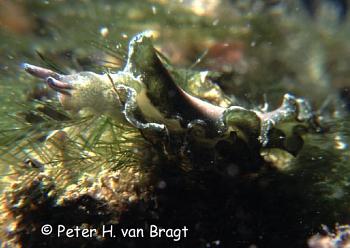
Hallo Bill,
Here are some images of Elysia viridis that have recently been found in the Netherlands:
These specimen were found at "De Zeelandbrug" (Zierikzee), Oosterschelde in August 2000
best regards
Peter H. van Bragt
vanbragt.phjm@hsbrabant.nl
van Bragt, P.H., 2000 (Oct 6) Elysia viridis from the Netherlands. [Message in] Sea Slug Forum. Australian Museum, Sydney. Available from http://www.seaslugforum.net/find/3006Thanks Peter,
I have put these two photos which show the range of colour variation together. In the greenish one you can see the green speckling on the head formed by the clusters of chloroplasts in fine ducts of the digestive system.
I have put your other two photos in a separate message because together they show the shape of an elysiid so well.
Best wishes,
Bill Rudman.
The shape of Elysia viridis
October 6, 2000
From: Peter H. van Bragt
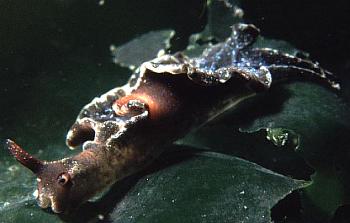
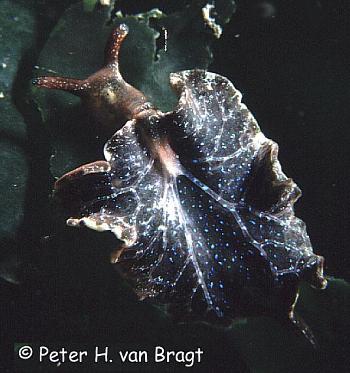
Hallo Bill,
Here are some more images of Elysia viridis that have recently been found in the Netherlands:
These specimen were found at "De Zeelandbrug" (Zierikzee), Oosterschelde in August 2000
Best regards
Peter H. van Bragt
vanbragt.phjm@hsbrabant.nl
van Bragt, P.H., 2000 (Oct 6) The shape of Elysia viridis. [Message in] Sea Slug Forum. Australian Museum, Sydney. Available from http://www.seaslugforum.net/find/3038Dear Peter,
I have separated thse photos from the others you sent of Elysia viridis as they show the shape of an elysiid so well. When the parapodial flaps fold out it clearly looks like a leaf. Eveline Marcus, and others have shown that the branching of the veins, so clearly visible in the lower photo are a useful character in distinguishing species.
What I am not clear of is the function of these veins. Perhaps Kathe Jensen or Cynthia Trowbridge could give us an idea.
Best wishes,
Bill Rudman
Observations on Elysia viridis
October 1, 1999
From: Andy Horton
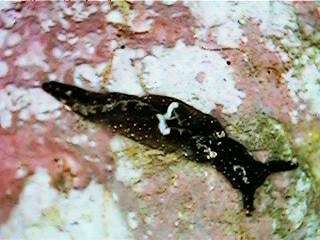
I found the discussion on Elysia viridis to be interesting. The popular literature in the UK states that this sacoglossan feeds on Codium. However, rock-poolers soon realised that it was unlikely that this was its sole diet, as it had been frequently been discovered where Codium was absent. I caught a very small specimen of Elysia viridis in a prawn net at Old Fort, Shoreham-by-Sea (near Brighton), Sussex, in an outer estuarine (full salinity) tide pool of the River Adur (English Channel).
This particular shore is dominated by Fucus serratus and Mussel beds, Mytilus edulis. There is a possibility that the green seaweeds Ulva and Enteromorpha are present, but they would need searching for. However, I have discovered the green algae Cladophora grows on Fucus serratus. This would seem its most likely food plant.
On another occasion I have discovered 4 juvenile specimens of E. viridis in Whelk, Buccinum undatum, egg cases, but I do not suspect they were feeding on the egg cases.
None of the juvenile specimens I have discovered on the Sussex coast have had any spots. They were a lime green colour, but the tinge varied under different lights.
The photograph is by Robert Jones of Trowbridge, England, of another small specimen from Dorset (English Channel).
Andy Horton
bmlss@compuserve.com
Horton, A., 1999 (Oct 1) Observations on Elysia viridis. [Message in] Sea Slug Forum. Australian Museum, Sydney. Available from http://www.seaslugforum.net/find/1386Dear Andy,
Determining the food of even the most common species can sometimes be more difficult than it seems. For a number of years I puzzled over the food of the common eastern Australian Rostanga arbutus. Clearly a sponge feeder, it was commonly found crawling over brown algae in tide pools, with no sign of a likely sponge food. It was only after taking a crowbar and geological hammer with me to crack open layers of the sedimentary rock that I found its food, a shade-loving bright orange red sponge Clathria aceratoobtusa. At the other end of the scale are animals which are always associated with an improbable food, but have never actually been seen eating, such as the gastropterids which are often found on sponges, but seem ill-equipped to eat them.
Bill Rudman.
Rudman, W.B., 1999 (Oct 1). Comment on Observations on Elysia viridis by Andy Horton. [Message in] Sea Slug Forum. Australian Museum, Sydney. Available from http://www.seaslugforum.net/find/1386Re: The food of Elysia viridis
August 22, 1999
From: Cynthia D. Trowbridge
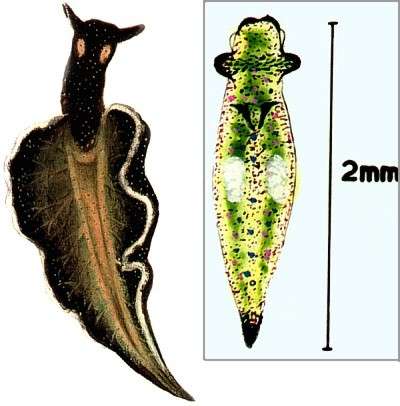
Dear Bill,
Hi. Here are two color drawings of Elysia viridis to demonstrate the past discussion on this species. The light green one is from Michael Miller's PhD thesis (1958); the slug was associated with Cladophora rupestris on the Isle of Man. The dark green one is from Meyer & Mobius (1865); I have not translated their paper yet but would hypothesize that the slug was eating Codium.
Reference: Miller, M.C. (1958) Studies on the nudibranchiate Mollusca of the Isle of Man. Ph.D. Thesis, University of Liverpool.
Thanks!
Cynthia
trowbric@bcc.orst.edu
Trowbridge, C.D., 1999 (Aug 22) Re: The food of Elysia viridis. [Message in] Sea Slug Forum. Australian Museum, Sydney. Available from http://www.seaslugforum.net/find/1224Re: Is Elysia viridis a single species?
August 15, 1999
From: Cynthia Trowbridge
Dear Kathe,
Thank you for your response!!! I have been looking in vain for your e-mail all week so I am delighted that you saw my message.
I am familiar with your electrophoretic work, and it supports my view that Elysia viridis is a single species, at least in the N. Atlantic and Mediterranean.
Ref Terry's (1987) report of Elysia viridis in South Africa, in the update of his book (published in Wayne Ellis' Australasian newsletter - Nov 1998), Terry has shifted E. viridis to Elysia sp.
But what about the record from China? I have just ordered that through inter-library loan the paper by Tchang-Si (1934). Have you ever looked at that description and/or specimens? I note that you did not include it in your 1985 Hong Kong paper.
Regarding my initial question, if body size, body color (from retained chloroplasts), and radular features are fully, or at least largely, inducible by diet AND if larval attributes (egg size, larval shell size, developmental rate) are all similar, then can I validly conclude that a sacoglossan/ascoglossan is a single species? At what point is variation species-level variation and what level is it phenotypic plasticity? As an ecologist, I would be keen to understand how the decision is actually made. I will need to shift over to private email (sorry Bill) for more detail.
Thanks in advance for your sharing your experience.
Cordially,
Cynthia
Oregon State University
trowbric@bcc.orst.edu
Trowbridge, C., 1999 (Aug 15) Re: Is Elysia viridis a single species?. [Message in] Sea Slug Forum. Australian Museum, Sydney. Available from http://www.seaslugforum.net/find/1191Dear Cynthia,
Sorry if I suggested I was opposed to private emails. Of course I'm not. I just think its extremely valuable for us all to keep in touch with each other and share our ideas and activities. If someone asks a question on the Forum, or sends a message, we are all waiting for the answer. If answers are sent privately just to the source, all the rest of us miss out. I have found your messages, and Kathe's very interesting - the sort of thing you hear in question time at a scientific conference. I personally find listening-in to these sort of conversations both interesting and educational.
Best wishes,
Bill Rudman.
The food of Elysia viridis
August 15, 1999
From: Cynthia Trowbridge
Bill,
Hi! Just a small correction regarding the information you have posted about Elysia viridis with a source of Thompson (1976)...there have been no studies demonstrating that the species actually feeds on the brown alga Cystoseira or the green algae Ulva and Enteromorpha. Thompson literally said "E. viridis has been found on a variety of algae"..."other authors recorded this sacoglossan from" Chondrus, Cystoseira, Codium, Ulva, Enteromorpha, and Zostera (p. 181). Furthermore, Michael Miller (PhD thesis, 1958) -- which was the major source for Thompson -- states that Elysia was on the macrophytes.
With sacoglossans, we have to be very careful about inferring trophic associations from animals sitting on specific macrophytes. Jensen has made this point in many of her papers in the 1980s....actual observations of feeding and ingestion are needed to establish a trophic (feeding) association.
All the best,
Cordially,
Cynthia
trowbric@bcc.orst.edu
Dear Cynthia,
Sorry for the lapse - a case of late night editing, which I have immediately rewritten. - a bit ironic after my recent discussion with Clay Carlson about being unconvinced that gastropterids feed on sponges just because they are always found on them!
Best wishes & thanks,
Bill Rudman.
Re: Is Elysia viridis a single species?
August 14, 1999
From: Kathe R. Jensen
To Cynthia Trowbridge's request for data about Elysia viridis:
After the malacological workshop in the Azores (1991, I think), I brought some live Elysia viridis from there back to Copenhagen. With Dr. Bent Theisen I did electrophoretic studies on these specimens as well as specimens from a few Danish localities and from either Plymouth, England or Roscoff, France (specimens had been stored in the freezer). Our results showed a highly polymorphic species, and we could not separate populations from the 3 regions. Unfortunately the data have been lost; when Bent Theisen retired, he gave me a bunch of gels and prints, but the Elysia data were missing, and he has not been able to locate them among his things, so we have not been able to publish. However, I think that E. viridis is one highly plastic species. On the other hand, I have doubts about the identity of the E. viridis from South Africa, published by Gosliner, 1987. There are so many externally similar, but anatomically different species in the Indo-Pacific southern hemisphere.
Kathe Jensen
KRJensen@zmuc.ku.dk
Jensen, K.R., 1999 (Aug 14) Re: Is Elysia viridis a single species?. [Message in] Sea Slug Forum. Australian Museum, Sydney. Available from http://www.seaslugforum.net/find/1186Re: Is Elysia viridis a single species?
August 10, 1999
From: Cynthia D. Trowbridge
Dear Bill,
Thank you for your response. Yes, in ecology, "cryptic species" could refer to those that match their background (which is pretty straight-forward) to those that are cryptic in the sense that they are difficult to distinguish from closely related species in the same or different regions. With the development of molecular techniques, we are finding many true species that were previously considered color morphs or variants.
Bill, you mentioned Placida dendritica, a species which has long fascinated me. In my mind, P. dendritica should be subdivided into many species; in fact they were originally described as regionally distinct species in New Zealand, South Africa, NE Atlantic, Japan, etc. As an ecologist, the animals in these different areas look and behave quite differently....VERY differently in my view but this is a rather controversial topic. I will send photos and drawings so you can judge the extent of geographic variation.
Elysia viridis is one of the best studied sacoglossans in the world...in all attributes: ecology, reproductive biology, physiology, etc. It is found in the NE Atlantic and Mediterranean; there are more questionable records of China, Japan, and South Africa. I believe the latter 3 records have now been been changed to other species .... I would welcome any information about the details.
Many sacoglossan "species" eat more than one algal food, often in different taxonomic groups. For example, Elysia viridis eats the filamentous algae Cladophora and Chaetomorpha as well as coenocytic algae Codium and Bryopsis. The slugs acquire chloroplasts from their food so their color is algal-derived, hence the different color "morphs"...not really comparable to color morphs in nudibranchs where the animal has different amounts of different pigments. Kathe Jensen has done excellent work on E. viridis with regard to Chaetomorpha vs. Codium diet...some individuals can learn to switch whereas others cannot (J. Moll. Stud. 1989). She has beautiful SEMs in more recent papers illustrating that there are differences in radular tooth shape and size associated with diet AND she demonstrated that tooth shape was inducible (i.e., by holding slugs from Codium on a Chaetomorpha and vice versa).
Bleakney has found a similar pattern with Placida dendritica (Veliger 1989, 1990) but he did not do the experimental switching of diets to see if radular morphology changed.
At what point is such variation enough to be species-level differences? I welcome discussion on this topic.
Thanks!!
Cordially, Cynthia
trowbric@bcc.orst.edu
Dear Cynthia,
I look forward to receiving your photos, and I'll look out some photos of the local 'Placida dendritica'
Bill Rudman.
Is Elysia viridis a single species?
August 9, 1999
From: Cynthia D. Trowbridge
Dear Bill,
I would be interested in hearing other people's views about cryptic species, their frequency in different orders of opisthobranchs, and what criteria should be used to determine whether taxa are different species vs. different forms, varieties, or races (i.e., exhibiting intraspecific variation). The issue becomes quite complex in taxa such as sacoglossans whose body size, body shape, color, and radular tooth attributes can all be influenced by diet.
In particular, I would also be curious if anyone thinks Elysia viridis in the NE Atlantic may not be a single species but rather two or more "cryptic species". I consider E. viridis to be a single good species but have been given the task of defending this on ecological, morphological, and genetic grounds. I am familiar with the work by Kathe Jensen, Michael Miller, and others on the species but would appreciate hearing about color, size, behavioral variation in E. viridis that may cause you to consider there are more than one species.
I look forward to discussing this issue with people. Please respond either to me directly or to the group. Thanks!!!
Cynthia D. Trowbridge
Research Assistant Professor
Hatfield Marine Science Center
Oregon State University, USA
trowbric@bcc.orst.edu
Trowbridge, C.D., 1999 (Aug 9) Is Elysia viridis a single species?. [Message in] Sea Slug Forum. Australian Museum, Sydney. Available from http://www.seaslugforum.net/find/1173Dear Cynthia,
I guess by 'cryptic species' you don't mean a species showing cryptic colour patterns (ie: camouflage), but rather a group of species difficult to distinguish from each other because of their morphological similarities.
I would be very interested in some examples of the sacoglossans you refer to whose body size, body shape, color, and radular tooth attributes can all be influenced by diet.
It would also be very useful if you could provide us with some photos of the different 'morphs' of Elysia viridis and of any of the other species which are polymorphic or perhaps are cryptic species groups. I guess the problematic Placida dendritica, which is supposed to have a worldwide distribution, is another good example.
While many of these northern hemisphere species are very familiar to you, and have spawned a huge and interesting literature, we in the southern hemisphere, though familiar with the literature, are unfamilar with the animals. I am happy to post pictures of these 'species' from throughout their geographic ranges, if it helps in stimulating discussion.
Concerning people responding directly to Cynthia or the Forum. If you respond directly to Cynthia could you send a copy to the Forum? I would like the Forum to be used more for open discussion, and open discussion dies very quickly if all the replies bypass the Forum.
Thanks to Daniel Geiger for another very welcome photograph.
Best wishes,
Bill Rudman.
Elysia viridis from the Netherlands
August 9, 1999
From: Peter H. van Bragt
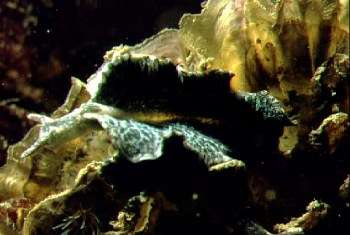
Dear Bill,
Here is a photo of Elysia viridis to add to the Netherlands' List.
Location: : Tholen (de Veerweg), de Oosterschelde, the Netherlands
With best regards
Peter H. van Bragt
Peter.vanBragt@ftn.hsbrabant.nl
van Bragt, P.H., 1999 (Aug 9) Elysia viridis from the Netherlands. [Message in] Sea Slug Forum. Australian Museum, Sydney. Available from http://www.seaslugforum.net/find/1174Dear Peter,
This photo arrived at a timely moment. I have just received a message from Cynthia Trowbridge asking what people think of the idea of this species being one of a group of very similar, but until now, unrecognised species.
Best wishes,
Bill Rudman.
Re: chloroplast symbiosis in Norway
March 10, 1999
From: Jussi Evertsen
Dear Bill.
I have been checking up on Elysia viridis since the time we last spoke, and there are found at least three different plastids from this species (I`ll send you the references later). This species feeds upon Ulva lactuca and is also recorded from Norwegian waters (I have also found it here from middle Norway). Thank you so very much for helpful information. I will come back to you about the topic.
Yours sincerely
Jussi
jussie@stud.ntnu.no
Evertsen, J., 1999 (Mar 10) Re: chloroplast symbiosis in Norway. [Message in] Sea Slug Forum. Australian Museum, Sydney. Available from http://www.seaslugforum.net/find/664Dear Jussi,
If you get a chance, a photo of your Elysia would be interesting.
Best wishes,
Bill Rudman.
Re: chloroplast symbiosis in Norway
March 10, 1999
From: Cynthia Trowbridge
Dear Jussi Evertsen,
I have read with much interest your messages about Elysia in Norway. I just spent almost two years studying Elysia viridis and Placida dendritica on Scottish rocky shores. Also, I even visited the Trondheim Biological Station in September 1998 before returning to Oregon (USA). I wished that I had met you during my visit.
With respect to Elysia, historically it fed on the filamentous green alga Cladophora rupestris (main host on Scottish shores)and the coenocytic green alga Codium tomentosum (rare on Scottish shores). Kathe Jensen has reported the slug eating Chaetomorpha linum in her J. Moll. Stud. paper in 1989.
Anyway, after the introduction of Codium fragile ssp. tomnentosoides to Scottish shores (1953), Elysia viridis primarily uses this alga as a host plant. The alga appeared on the shores of mainland Europe several decades earlier and the slug eats presently eats it.
In terms of references, I have written 2 manuscripts (about to be submitted) and then two recent papers that also include details about Elysia and Placida that may be of interest:
Trowbridge (1998) J. Exp. Mar. Biol. Ecol. 230: 31-53.
Trowbridge (1998) Oceanogr. Mar. Biol. Ann. Rev. 36:1-64. (despite its algal title, there is quite a bit of slug info).
You might also check for the January 1999 issue of American Zoologist where I have a published abstract on Elysia viridis.
I would be keen to hear more about your research. Thanks!
Cynthia Trowbridge
Research Assistant Professor
Oregon State University
trowbric@ucs.orst.edu
Trowbridge, C., 1999 (Mar 10) Re: chloroplast symbiosis in Norway. [Message in] Sea Slug Forum. Australian Museum, Sydney. Available from http://www.seaslugforum.net/find/666